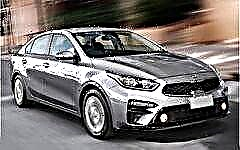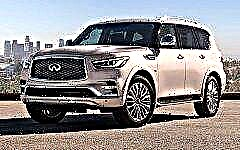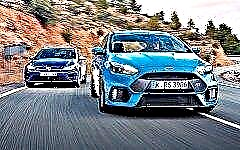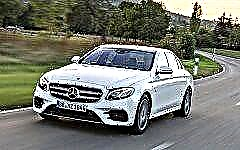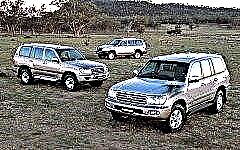

The content of the article:
- SUV and reliability: words that need to be connected!
- Japanese SUVs
- Reliable Japanese SUVs
For decades, the Japanese car industry has been featured in the automotive markets of the world as the quintessence of reliability and excellent quality. There are enough reasons for this image: from a really scrupulous approach to design and assembly to a well-thought-out sales strategy.
Let's try to select the "best of the best" in the class of SUVs - Japanese models, which next year will take the first positions in the rating of reliable cars.
SUV and reliability: words that need to be connected!

Why are we interested in the reliability of SUVs, and not, say, their maximum speed or fuel consumption? The reason is quite obvious and simple. An SUV, as the name implies, is a car that is designed to cope not with the ideal asphalt surface in urban areas, but with off-road driving over rough terrain. Consequently, there is a great chance that the car will move far from civilization, and even in conditions that are far from ideal.
It is quite logical to demand reliability from such transport in the first place: the driver and passengers of the car should know that, even if not too quickly, albeit with a sufficiently high fuel consumption, the car will easily deliver them from point A to point B without harming health and condition of people.
And the car itself after a difficult road must survive and maintain its working qualities so that in the future it can be used with pleasure for its intended purpose - after all, as a rule, SUVs are not cheap, so the owner has the right to expect a good working resource from the car.
Japanese SUVs

The design and assembly of vehicles with a high level of cross-country ability in Japan has been established for a long time. A country with difficult terrain simply could not pass by such a segment of car models.
Having closed the needs of the domestic market, Japanese manufacturers paid attention to the needs of the external market. Toyota became one of the first companies to start selling off-road vehicles of its own production abroad.
Today it is believed that an SUV must have a range of features and characteristics, which, in fact, make the car an SUV:
- high-power engine (minimum - one and a half liters and 120 hp);
- large ground clearance that allows you to overcome obstacles;
- four-wheel drive (although an adjustable option is also possible);
- a manual transmission (although “automatic machines” appear more and more in modern models);
- supporting frame, allowing to give the vehicle strength and rigidity;
- large tire diameter, special tread that guarantees good grip on the ground;
- voluminous trunk.
For Russia, Japanese SUVs are very well suited, "fitting" into the harsh climatic conditions, because in Japan, too, is not a year-round resort - snowfalls and glaciers in this country will surprise and scare no one.
Assessing this feature, the managers of Japanese manufacturers made a bet on the sale of SUVs in Russia, which are distinguished by an increased level of reliability, and they did not lose.
While there are similarities inherent in reliable off-road vehicles, there are many variations of this type of vehicle. Japanese manufacturers offer SUVs of various sizes:
- compact;
- medium-sized;
- full-size.
Let's see what models in these size categories will be the most in demand next year.
Reliable Japanese SUVs
7. Nissan Patrol

This Nissan car was first released in the middle of the last century. Since then, the car has been repeatedly improved and changed. Today, the model occupies leading positions in international ratings according to many expert organizations.
Today the sixth generation of Patrol is being produced. This is a full-size SUV with a width of 2 and a length of 5.14 m. A remarkable fact is the presence of this model in service with a number of states in Europe and Asia: this indicates that the car is really reliable - as a rule, others are not kept in armies.
Under the hood, the Nissan Patrol has a 405 hp engine. The ground clearance of the model is 27.5 cm, which allows the car to easily overcome rough terrain. Over the years of operation, the undercarriage of the model has been tested in almost all climatic zones and natural conditions.
The modern Nissan Patrol model has changed significantly in terms of interior trim and equipment. Traditionally, SUVs could not boast of special attention to comfort: the reliability of the design was put in the first place. But the sixth model Nissan Patrol is already completely different accents in terms of driver convenience: climate control system, electric tailgate, electric mirrors, power steering - all this creates comfort.
The combined fuel consumption of the gasoline engine is 16.2 liters per 100 kilometers. For Russia, a model in a new body will cost from 4.5 million rubles.
Perhaps, high fuel consumption and high price are the only "minuses" of the model.
6. Mitsubishi Pajero

In the photo: Mitsubishi Pajero Sport
An all-wheel drive full-size SUV with excellent driving characteristics. This model has repeatedly emerged as a winner in various cross-country and off-road races. In particular, Mitsubishi Pajero is the winner of many awards of the famous Paris-Dakar rally.
This SUV features a robust base platform. Those who have been using Mitsubishi Pajero for a long time in Russian off-road conditions note that the model has an extremely low level of breakdowns even with aggressive use.
A special feature of Mitsubishi Pajero is its ability to overcome water obstacles up to 0.7 m deep.
The model is produced with a diesel or gasoline engine. The width of the model is 1.88 m, the length is 4.9 m. The trunk can be easily increased due to the folding rear row seats.
A separate point is the conservatism of Mitsubishi's design. The exterior of this SUV has changed minimally over time, only paying tribute to the most important trends in technical innovation designed to increase the reliability of the structure.
The fuel consumption of the Mitsubishi Pajero in the petrol version is about 16.6 liters per 100 km of the combined driving cycle. In the salons of Russian dealers, the price of a car starts at 2.3 million rubles.
5. Isuzu D-Max

This model may not be known to everyone, and nevertheless, it has its own niche. As a rule, it is appreciated by residents of rural areas, hunters and fishermen. The reliability of the chassis, endurance and durability of this pickup truck are its main "trump cards" in the automotive market.
The model is a kind of hybrid of a practical mini truck, the convenience of a passenger car and the cross-country ability of an all-terrain vehicle. There are two model options available on our market: with a double and one-and-a-half cab.
The width of the Isuzu D-Max is 1.86 m, the length is 5.3 m. The height of the ground clearance is 22.5 cm. This mid-size car is able to carry loads weighing up to a ton - we agree, for those who live in rural areas, an important plus!
Another advantage of the model is its economy. Fuel consumption in the diesel version in the combined cycle is about 8.5 liters for every 100 kilometers.
In the basic configuration, the car will cost the buyer in the amount of 2, 15 million rubles. Manufacturers offer a choice of six types of configurations - for every taste and wallet.
4. Lexus GX

This mid-size SUV is marketed as a model that was born after reliability, power and increased cross-country ability were no longer the only requirements for SUVs.
The designers have set themselves the goal of consistently and thoughtfully providing the model with all systems that will provide the driver and passengers with comfort and, of course, high safety.
The car is mounted on a unified frame-type base, which is created from a special alloy and is used immediately in a number of Lexus models. Russian drivers note the high stability of the model on icy bends and ice.
The width of the Lexus GX is 1.87 m, the length is 4.81 m. The ground clearance is 21.5 cm.
The fuel consumption of the petrol engine of the model is about 14 liters per 100 km on the combined cycle. The price of the car may be somewhat upsetting - in the new body it is from 4.5 million. But Lexus is Lexus, brand fans know well what they pay their money for!
3. Suzuki Jimny

Looking at this SUV, many will immediately say: "Japanese!". A very compact model, which, nevertheless, is not inferior in reliability to its more dimensional "brothers".
The car is designed on the basis of a ladder frame with rigid wheel suspension. There is enough space for the driver and front seat passenger - you can easily accommodate not even "Japanese" dimensions. But as for the back row seats - a normal Russian person will clearly be cramped on them.
The trunk is not too happy, if you can call it that compartment into which you can hardly cram a medium-sized bag.
From the point of view of comfort, the model fully meets modern requirements: climate control, electric heated exterior mirrors, automatic window lifters - all this is present. The implementation of security systems is also up to the mark.
Suzuki Jimny's fuel consumption is approximately 8.3 liters per 100 km of combined driving cycle. The price of the model is from 1.4 million rubles, and this is one of the reasons why buyers often turn a blind eye to the small dimensions of the car, because with its compactness it retains the main characteristic necessary for an SUV - reliability!
2. Mitsubishi Pajero Mini

Another "kid" in the family of Japanese SUVs. In fact, this is a "truncated version" of the Mitsubishi Pajero version, beloved by car owners.
The reason for the development of the Pajero Mini was the results of market research. In the 90s of the last century, it turned out that there were a lot of requests for the purchase of off-road vehicles, but the price of the models on the market was not affordable for everyone.
Mitsubishi owners have made the decision to meet the aspirations of the “cash-strapped youth” with a smaller car.
The width of the Mitsubishi Pajero Mini is 1.48 m, the length is only 3.3 m. The ground clearance is 19 cm. The car was made deliberately lightweight. A solid metal body was mounted on the frame, a 6.4 hp engine was installed. This decision led to the fact that a light car easily overcomes even swampy, "weak" soils.
Mitsubishi Pajero Mini is especially popular in Russia among residents of the Far East region.
Of the minuses, we can mention, perhaps, the fact that there is an airbag only at the driver's seat. Mitsubishi Pajero Mini price starts at 2.7 million rubles.
1. Toyota Land Cruiser

This car is a kind of legend of the Japanese car industry, an ageless model, known almost all over the world.
The car is designed according to the principle “everything is ingenious - simple!”: The most simple, but at the same time high-tech platform is the basis that provides the car with excellent cross-country ability in almost any conditions. It is noteworthy that the frame used in the construction of the machine is used in a number of other models.
Car owners appreciate the Toyota Land Cruiser engine's ability to withstand up to 300,000 km before the next major overhaul. Manufacturers of other SUVs are not yet able to create a similar diesel engine, simple and reliable.
The model has earned a separate "plus" due to its body: it is highly resistant to rust, which is important in a humid climate.
The width of the model is 1.95 m, the length is 4.9 m. The ground clearance is 23 cm. The car is designed for 8 people. If you fold the rear row seats, you can get a fairly roomy trunk.
The price of the legend of Japanese SUVs is quite high - from 4.9 million rubles. But we agree that the reliability and excellent driving characteristics are worth it!
Conclusion
What paths the further development of the Japanese car industry will follow is known only to the Japanese manufacturers themselves. So far, the following is clear - with a scrupulous approach to the development and assembly of cars, as well as the ability to calculate the requirements of the market, Japanese specialists have ensured that most of the SUVs produced in the Land of the Rising Sun are associated with the concept of reliability among car owners around the world. This means that in the near future these models will remain at the peak of sales charts.




